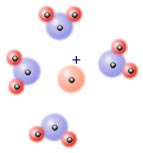


|
|||
 |
| ||
Intermolecular Forces | |||
Ion - dipole and ion - induced dipole forces
When an ionic substance dissolves in a polar solvent (that is, a solvent whose molecules have a permanent dipole moment) the majority of the solvent molecules orient themselves with the oppositely charged end of the solvent molecule near an ion. For example, in the picture on the left, the positive ion is surrounded by water molecules which mostly have their negative end (at the oxygen atom) pointing towards the positive ion. This attraction between the ions and the solvent molecules can win out over the attraction of the ions to each other, allowing the substance to stray in solution. For an insoluble ionic substance this may not be the case. Ion - dipole forces are largely responsible for the dissolution of ionic substances in water. If a neutral, non-polar molecule approaches an ion, the ion will induce a dipole moment in the molecule and thus the ion and molecule will be attracted to each other. The strength of this force will depend on the charge on the ion and the polarisability of the molecule. The hemoglobin molecule contains four Fe2+ ions. Hemoglobin carries oxygen from parts of an animal where it is abundant (the lungs) to parts where it is needed. In the early stages of the binding of an oxygen molecule to the Fe2+ ion in hemoglobin it is the ion - induced dipole force which brings the O2 towards the Fe2+.
|